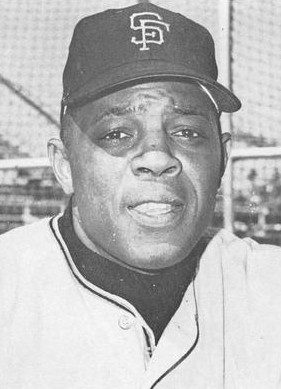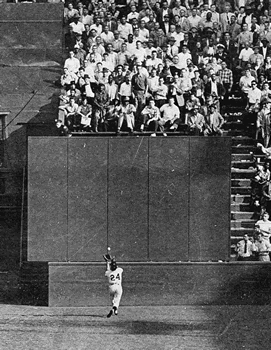By Dan Hock

FROM WIKIPEDIA COMMONS
Willie Howard Mays Jr. (May 6, 1931 – June 18, 2024), nicknamed “the Say Hey Kid“, was an American professional baseball center fielder. Regarded as one of the greatest players ever, Mays ranks second behind only Babe Ruth on most all-time lists, including those of The Sporting News and ESPN. Mays played in the National League (NL) between 1951 and 1973 for the New York / San Francisco Giants and New York Mets.
Born in Westfield, Alabama, Mays was an all-around athlete. He joined the Birmingham Black Barons of the Negro American League in 1948, playing with them until the Giants signed him upon his graduation from high school in 1950. He debuted in Major League Baseball (MLB) with the Giants and won the Rookie of the Year Award in 1951 after hitting 20 home runs to help the Giants win their first pennant in 14 years. In 1954, he won the NL MVP Award, leading the Giants to their last World Series title before their move to the West Coast. His over-the-shoulder catch in Game 1 of the 1954 World Series is one of the most famous baseball plays of all time. After the Giants moved to San Francisco, Mays went on to win another MVP Award in 1965 and also led the Giants to the 1962 World Series, this time losing to the New York Yankees. He ended his career with a return to New York after a mid-season trade to the New York Mets in 1972, retiring after the team’s trip to the 1973 World Series. He served as a coach for the Mets for the rest of the decade, and later rejoined the Giants as a special assistant to the president and general manager.
A 24-time All-Star, tying him for the second most in history, Mays became a perennial MVP candidate, finishing in the top six in the voting in eleven of the next twelve seasons, twice as runner-up in 1958 and 1962. He led the NL in home runs four times and in slugging percentage five times while batting over .300 and posting 100 runs batted in (RBI) ten times each. Mays was also at the forefront of a resurgence of speed as an offensive weapon in the 1950s, leading the league in stolen bases four times, triples three times and runs twice, with his 179 steals during the decade topping the major leagues. He was the first NL player to hit 30 home runs and steal 30 bases in the same season, the first player in history to reach both 300 home runs and 300 stolen bases, and the second player and the first right-handed hitter to hit 600 home runs. Mays also set standards for defensive brilliance, winning 12 consecutive Gold Glove Awards after their creation in 1957, still a record for outfielders; he led NL center fielders in double plays five times and assists three times.
A classic example of a five-tool player, Mays finished his career with a batting average of .302. At the time of his retirement, he held the NL record for career runs scored (2,062), and ranked second in league history behind Stan Musial in games played (2,992), third in home runs (660), at bats (10,881), runs batted in (1,903), total bases (6,066), extra-base hits (1,323) and walks (1,464), fourth in hits (3,283), fifth in slugging percentage (.557), and eighth in doubles (523); his 140 triples ranked fourth among players active after 1945. He holds major league records for games as a center fielder (2,829), putouts as an outfielder (7,095) and extra-inning home runs (22), and ended his career behind only Ty Cobb in total games as an outfielder (2,842) and ranking seventh in assists (188) and third in double plays (59) in center field. Mays was elected to the Baseball Hall of Fame in 1979 in his first year of eligibility, and was named to the Major League Baseball All-Century Team in 1999. Mays was awarded the Presidential Medal of Freedom in 2015.
Mays’ final public statement came on June 17, 2024, to the San Francisco Chronicle when he said he elected not to attend the MLB at Rickwood Field game between the Giants and Cardinals later in that week on June 20. Mays died the following day, at the age of 93 of heart failure, at a care home in Palo Alto, California.

